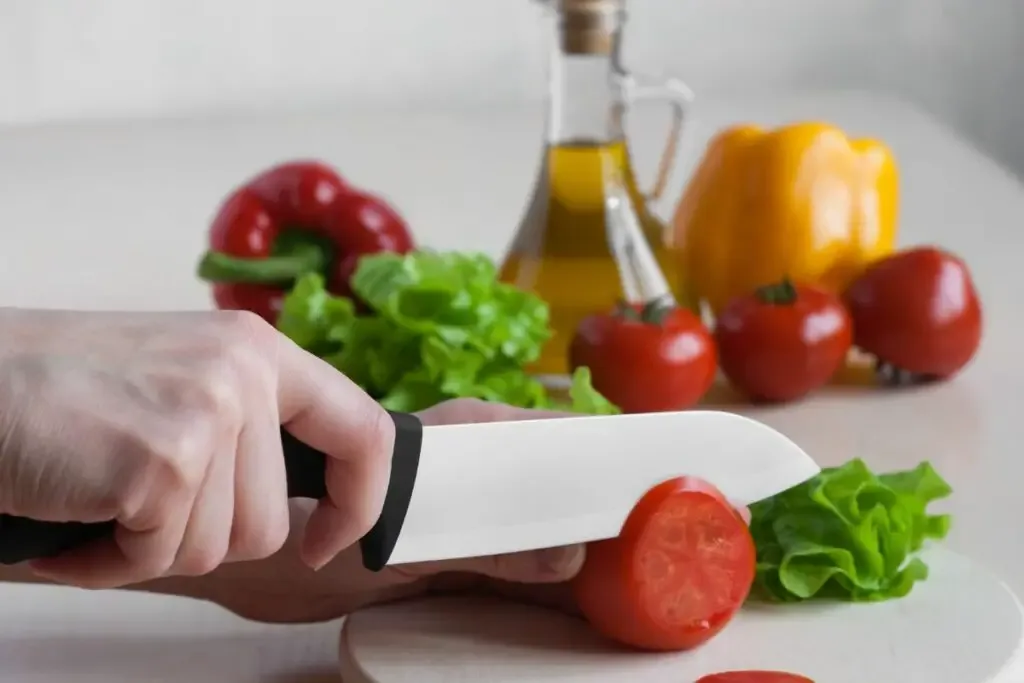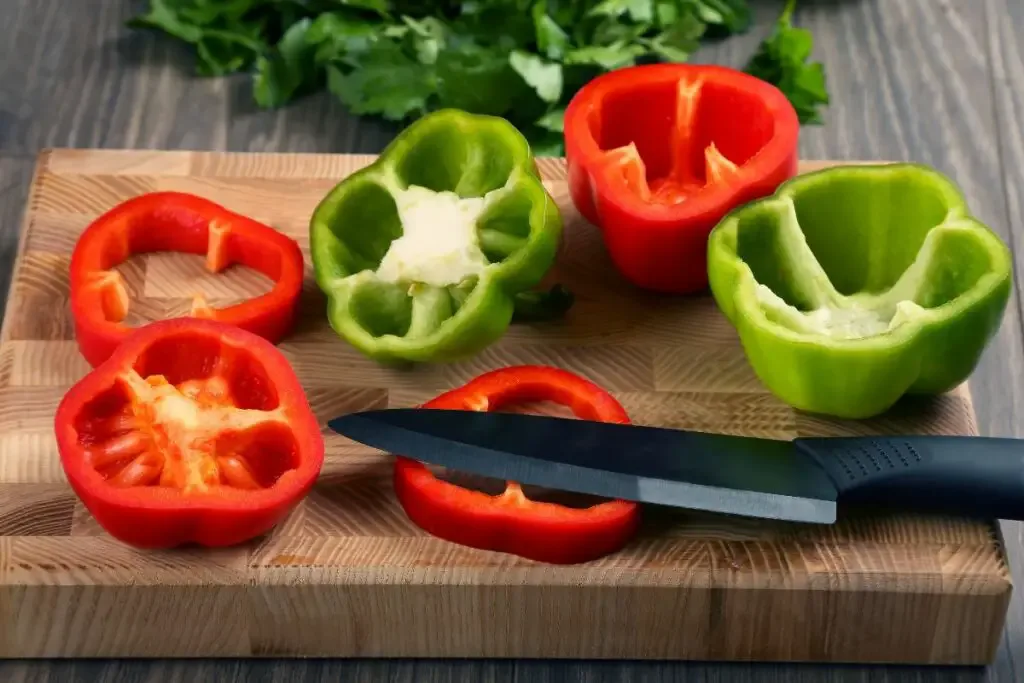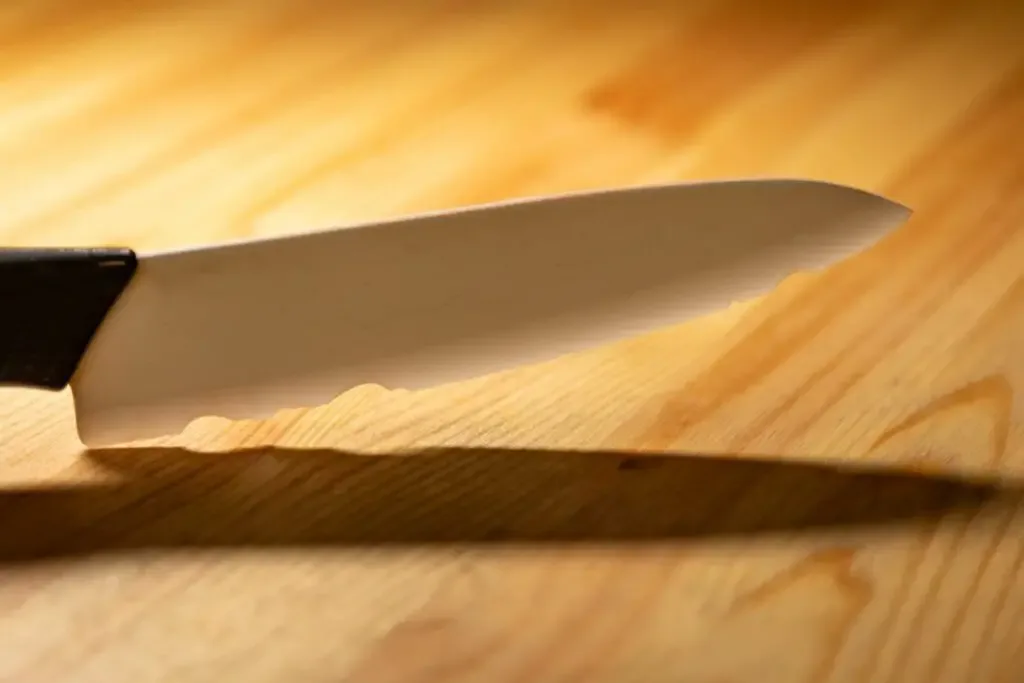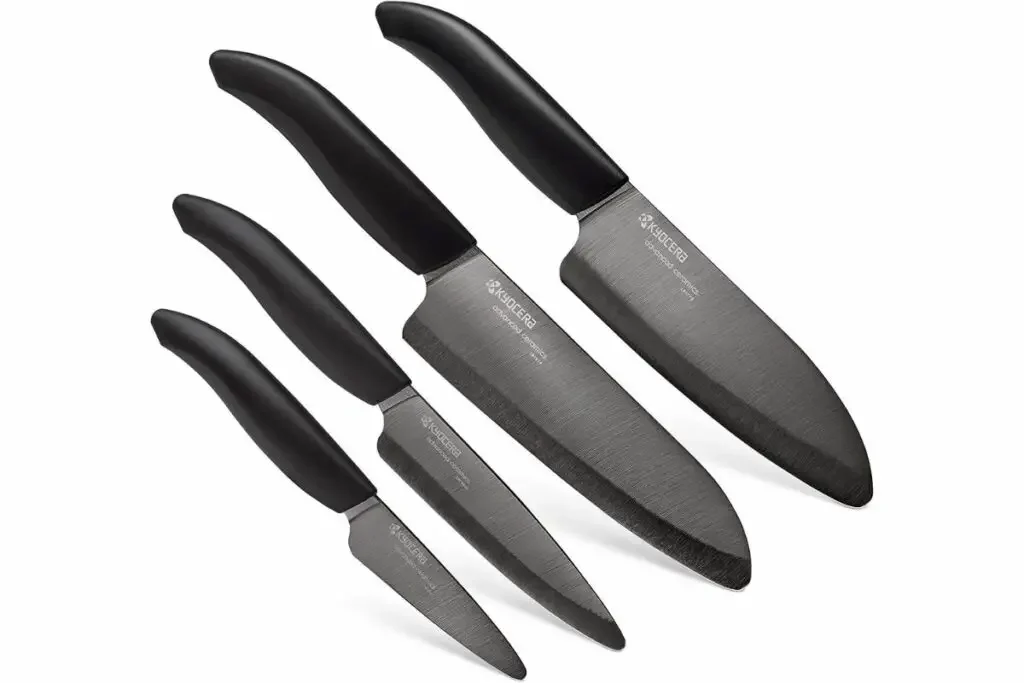As an Amazon Associate, we earn from qualifying purchases with no additional costs for you.
Ceramic Knives – Friend or Foe? This is a question many debate, experts and amateurs alike. One of the methods used for determining the hardness of extremely hard materials is the MOH scale. The hardest material known to man is the natural diamond which is classed as 10 on this scale. A good quality hardened steel, as used to make the knife blades that we are familiar with, would register somewhere around 5,5 on the MOH scale.
Ceramic kitchen knives are extremely sharp and retain an edge significantly longer than steel knives. While ceramic knives have many advantages over steel knives, they also have disadvantages that may result in them being unsuitable in certain circumstances. The brittleness is the main drawback.
What is commonly known as ceramic is one of the hardest materials on our planet and would register a shade over 8 on the same scale. The ceramic knives in your kitchen fall into this category, just below Tungsten steel. In second place but still over 9 comes the man-made cubic zirconia (commonly known as fake diamonds).
If you are interested in checking out the best ceramic kitchen knives we recommend and use, you can find them by clicking here (Amazon link).
Ceramic Kitchen Knives Pros And Cons

Ceramic knives have many desirable characteristics, including extreme hardness, which allows for long-life razor-sharp edge retention. They are impervious to penetration or contamination by water, oils, alkalis or acids, and any food products.
The major drawback is that ceramics are brittle, very brittle. They do not withstand shock at all well, so they can easily chip if abused, and under lateral forces, they will never bend or flex to any degree but will break first.
The Ceramic knife blade is manufactured using a process perfected by the Japanese during the late 1990s is made from a high-tech material called Zirconium Oxide.
This gives the blade the characteristics of being immune to corrosion, a hardness second only to diamond, very dense but super light, anti-magnetic, and unaffected by any kitchen-related high temperatures.
Specialized ceramic tiles formed part of the space shuttle’s protective shield against the intense heat generated by friction as it entered the earth’s atmosphere at some 17500 miles per hour.
The heat generated at the high heat points on the shuttle at that stage was around 2750 degrees Fahrenheit. You need some super-specialized material to protect a craft under those conditions, and ceramics proved up to the task. What better material to try making knives with?
TIP: Ceramic knives are great for certain kitchen tasks, but they have limitations. Choosing the best kitchen knife for your needs requires investigation. Find some expert tips in our article below!
Buyer’s Guide: How To Choose The Best Kitchen Knife For You
Are Ceramic Knives Good
Yes, ceramic knives are good, very good. They have some serious advantages over steel blades. They can be sharpened to a degree way beyond that of a steel knife, and they will hold that edge far longer than a steel blade could.
The blade material is also 100% rust-proof, does not tarnish, is non-magnetic, and is impervious to contamination by oils, foodstuffs, etc. As in everything knife related, there are trade-offs to be made.
Ceramic knives are brittle, so they do not bend but will break first. When the edge does get dull, they require a specialized sharpening process, using diamond abrasives, and some skill, to restore the edge.
We are familiar with ceramics as being the material that our cups, saucers, and plates are made from. Ceramic household crockery is made by applying intense heat to silica clay after it is pressed or molded into shape.
A super-hot glazing process follows, and it is this firing that creates a hard yet fragile end product. But drop one of them on the floor and break it, then run your finger along the edge and see how quickly and effortlessly you can cut yourself.
Ceramic knives are made in a similar manner, but the base material is an ultra-high-tech ceramic compound called Zirconium Oxide. This compound is first reduced to powder form and then mixed with various additives.
The subsequent mix is poured into a knife-shaped mold and pressed down at extremely high pressure, some 13000 psi (pounds per square inch). By comparison, an automobile tire is inflated to around 32 psi. The pressed ceramic powder is then “sintered” in that mold at a very high temperature, around 3632 degrees Fahrenheit (2000 degrees Celsius).
Sintering is the process of heating a compound, e.g., a metal in powder/granulated form, to the point just before it reduces to a liquid state. At that temperature, the compound binds with itself and forms a homogeneous mass.
In the making of a ceramic knife, this process results in a knife blade blank that encompasses numerous unique and highly desirable properties.
The final shaping of the knife, in other words, grinding away all the bits that don’t look like a knife, is accomplished by using diamond-based grinding/cutting media. The fitting of the handle (known as slabs in knife terms) and final sharpening using diamond media again to finish off the knife.
So, these beauties are made from ceramic, but it’s not the same material as the plates In your kitchen. This is serious nano high technology. Looked after, they are going to be around your kitchen and still be sharp for quite a while.
Lab-Grown Diamonds For Ceramic Knives
Lab-grown diamonds, as opposed to natural diamonds, have the same characteristics as real diamonds and will also register 10 on the MOH hardness scale. A naturally occurring, very hard ceramic, but also very rare, is moissanite.
This is a silicon carbide mineral that hits 9.2 on the MOH scale. But Technology never stops; moissanite is now also lab-grown and is used extensively in jewelry.
Believe it or not, it is cheaper and shinier than a diamond. A Cubic Zirconia, as used in jewelry, is really a ceramic. It pretty much looks like a diamond and is nearly as hard, but the “stone” itself is worthless. The ring setting is probably worth more.
Do Chefs Use Ceramic Knives?

With professional chefs, the most common and versatile knife in their armory is the chef’s knife. Made of high-grade stainless steel, robust in design, easily sharpened, and comfortable to use.
It can be used to chop vegetables and slice meat and will withstand a little abuse. Not that a chef abuses his knives as they are the tools of his trade, and replacing them becomes expensive.
Arrayed in that armory as well will be several specialist steel knives such as meat cleavers, boning knives, pairing knives, serrated knives, etc.
Notwithstanding the above, there is definitely a space in the professional chef’s toolbox for an ultra-sharp, naturally lightweight ceramic knife. Particularly as that sharp edge is reputed to stay sharp up to 11 times longer than a quality steel blade.
The negative here is that when it gets dull, re-sharpening requires a diamond abrasive to cut a new edge, and the process is quite time-consuming. Some manufacturers do offer a re-sharpening service for their ceramic knives, but then you would need at least two to cover the downtime!
The ceramic knife is unquestionably much more fragile than its steel counterpart. Drop one on the floor, and having the blade snap in half is a very real possibility. Thereafter you put it in the bin and buy a new one.
It also cannot be classed as an all-purpose knife. Using the ceramic knife to chop through tough fibrous vegetables or even thin bones in meat runs a real risk of chipping the hard, sharp, yet brittle blade edge.
The same applies to using it to pry bones or frozen foods apart; you are more than likely going to snap the blade in half or at least snap the point off. Again, into the bin.
Continual advances in the technology of ceramics have resulted in ceramic knives being a little less fragile, but they still need to be used with care and never abused. They also need to be stored correctly.
TIP: Understanding what you can and cannot cut with your ceramic kitchen knife will help to make your ceramic knives last longer. Find out more in our article below!
Explained: What To Cut & NOT To Cut With A Ceramic Knife
Pros of Ceramic Kitchen Knives

Ceramic knives are substantially harder than steel knives, nearly 40% harder in most cases. But amazingly, they are way lighter than steel. Ceramic knives have a density of around 5 as compared to stainless steel at about 8. They are thus pretty much half the weight of steel which goes a long way if you are using it all day.
Ceramics are exceptionally resistant to strong acids and alkalis. The strengths of these substances in the food world are comparatively low anyway, so a ceramic knife won’t even know it is there. This also means that you are not going to get tarnishing or blemishes on a ceramic blade.
With a hardness second only to that of a diamond (and moissanite), the cutting edge of a ceramic knife retains its sharp cutting edge some 11 times longer than a steel knife blade would when used in the same circumstances. This edge retention makes it a major contender for a slot in your kitchen knife box. Note-knife box, not cutlery drawer.
Corrosion is not an issue with ceramic knives; they do not rust ever, so maintenance is low. Even stainless-steel knives can rust if not cared for.
Stainless steel knives are highly resistant to rust but not immune to it. There is an iron content in stainless, and it is the iron reacting with oxygen that causes the onset of rust.
Ceramics also does not conduct electricity, which is probably irrelevant in knives as one is very unlikely to go around poking their knives into live electricity outlets. Though, that has probably happened before with predictable results.
In a nutshell, ceramic knives have numerous characteristics that are not matched by steel knives. They have high wear resistance, are very light with an excellent weight/strength ratio, and are extremely hard, giving them good edge retention. Their high density means they are non-porous, so dirt and food, etc., cannot get stuck there, making them easy to clean.
PRO TIP: We personally use diamond plates by Atoma. They are quite expensive but of the top quality with very long service life.
The initial costs are higher but you have an option of buying replacing diamond skin for all Atoma plates. The costs of replacing diamond skin are much lower than the cost of buying a new diamond plate.
So if you are going to use diamond plates regularly and want to get the best quality on the market, check out the four Atoma diamond plates listed below (Amazon links).
- Atoma Diamond Sharpener Coarse Grade 140 Grit
- Atoma Diamond Sharpener Medium 400 Grit
- Atoma Diamond Sharpener Fine 600 Grit
- Atoma Diamond Sharpener Super Fine 1200 Grit
These 4 diamond sharpening stones are all you need to have for repairing or sharpening your knives.
Cons of Ceramic Kitchen Knives

That hardness which allows the ceramic knife to remain super sharp far longer than steel has a major downside. Ceramic is a notoriously hard but extremely brittle, almost fragile material and will break or chip very easily.
Particularly if dropped, twisted into a bone joint, or used in a chopping action. This negates them from being classified as “an all-purpose kitchen knife.”
All ceramic knives are non-magnetic, which could be a pro or a con. The con is that if you use a magnetic knife holder, you won’t be putting your ceramic knife there.
Knives made from ceramics are impossible to sharpen without the aid of a diamond-impregnated cutting medium. Even then, the sharpening process is not simple, and it is time-consuming.
Standard knife makers grinding belts does nothing to ceramic knives; they simply ruin the belt. This makes the ceramic knife way more difficult to sharpen than a steel knife. Sure, the edge lasts longer, but when dull, you cannot quickly whistle up a new edge on a sharpening steel or a whetstone.
TIP: Ceramic knives can chip can crack, but you may be able to save your ceramic kitchen knife! Check out some pro tips to fix a cracked or chipped ceramic knife in our article below!
Step-By-Step Guide: How To Fix A Chipped Ceramic Knife
Best Ceramic Kitchen Knives Set
With any knife product, it is a given that you get what you pay for. Just as you get cheap steel knives, you will get cheap ceramic knives.
When a top-quality ceramic knife set of three is marketed at over $120 a set, it is given that the $29 set of six that just caught your eye will have some shortcomings in durability, toughness, engineering, and edge retention.
A cheap steel knife will not hold its edge for as long as a quality steel knife, but at least you can still sharpen it frequently; at a push, you could sharpen it, albeit badly, on a rock. Not so with your cheap ceramic knife. It is still ceramic, and you are not going to sharpen it easily.
Kyocera Revolution Ceramic Knife Set

The popularity and great reviews on this ceramic knife set (Amazon link) give one a pretty good idea of the quality ceramic knives they make in the Kyocera factory.
Kyocera started its venture in 1959 in Kyoto, Japan, and they are now a world leader in ceramic knives as well as a global player in the markets for cell phones, office equipment, and kitchen-related ceramic products.
In 2022 Kyocera was awarded its 34th patent, putting them as front runners in knife-making technology. Backed by their two-year warranty against defects, they are putting their money where their mouth is. I like that a lot! But please note that dropping the knife and breaking it on your tiled floor is not covered.
This four-piece set is value for money and gives you a range of options. The handles are durable alloy steel and propriety zirconia ceramic blades. They look amazing, perform well, and are super-sharp.
Conclusion
At least now you can make an informed decision on which suits you best. Ceramic technology is being improved upon all the time; it works beautifully on knives.
They slice your veggies like a hot knife through butter, but they are fragile, particularly the cutting edge, which will chip easily. You do not throw these into your drawer full of knives to get bashed around. You will pay dearly for that.
TIP: The right cutting board can make a significant contribution to the durability of your ceramic knife. Find out the best cutting boards to use in our article below!
3 Best Cutting Boards For Your Knives (Materials Compared)
